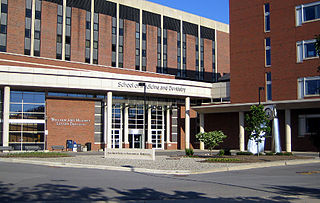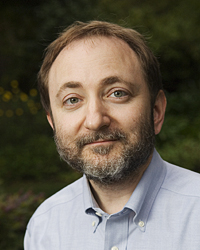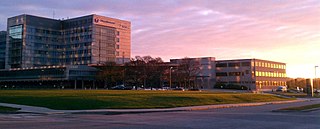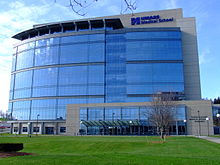
The University of California, San Francisco (UCSF) is a public land-grant research university in San Francisco, California. It is part of the University of California system and is dedicated entirely to health science and life science. It conducts research and teaching in medical and biological sciences.

The University of Massachusetts is the five-campus public university system and the only public research system in the Commonwealth of Massachusetts. The university system includes five campuses, a satellite campus in Springfield and also 25 campuses throughout California and Washington with the University of Massachusetts Global.

Baylor College of Medicine (BCM) is a medical school and research center in Houston, Texas, within the Texas Medical Center, the world's largest medical center. BCM is composed of four academic components: the School of Medicine, the Graduate School of Biomedical Sciences; the School of Health Professions, and the National School of Tropical Medicine.
The University of Texas Southwestern Medical Center is a public academic health science center in Dallas, Texas. With approximately 23,000 employees, more than 2,900 full-time faculty, and nearly 4 million outpatient visits per year, UT Southwestern is the largest medical school in the University of Texas System and state of Texas. The institution has been consistently ranked among the top medical schools in the United States.

Scripps Research, previously known as The Scripps Research Institute (TSRI), is a nonprofit American medical research facility that focuses on research and education in the biomedical sciences. Headquartered in San Diego, California, the institute has over 170 laboratories employing 2,100 scientists, technicians, graduate students, and administrative and other staff, making it the largest private, non-profit biomedical research organization in the United States and among the largest in the world.

Oklahoma State University Center for Health Sciences (OSU-CHS) is a public medical school in Tulsa, Oklahoma. It also has a branch campus in Tahlequah, Oklahoma. Founded in 1972, OSU-CHS is part of the Oklahoma State University System. OSU-CHS offers a Doctor of Osteopathic Medicine (D.O.) and over fifteen other different graduate degrees.
The Vanderbilt University Medical Center (VUMC) is a medical provider with multiple hospitals in Nashville, Tennessee, as well as clinics and facilities throughout Middle Tennessee. VUMC is an independent non-profit organization, but maintains academic affiliations with Vanderbilt University. As of 2022, the health system had more than 3 million patient visits a year, a workforce of 40,000, and 1,709 licensed hospital beds.

The University of Rochester Medical Center (URMC), now known as UR Medicine, is located in Rochester, New York, is one of the main campuses of the University of Rochester and comprises the university's primary medical education, research and patient care facilities.
A biomedical scientist is a scientist trained in biology, particularly in the context of medical laboratory sciences or laboratory medicine. These scientists work to gain knowledge on the main principles of how the human body works and to find new ways to cure or treat disease by developing advanced diagnostic tools or new therapeutic strategies. The research of biomedical scientists is referred to as biomedical research.
The Duke University School of Medicine, commonly known as Duke Med, is the medical school of Duke University. It is located in the Collegiate Gothic-style West Campus of Duke University in Durham, North Carolina. The School of Medicine, along with the Duke University School of Nursing, Duke University Hospital, Duke Regional Hospital, Duke Children's Hospital, Duke Raleigh Hospital, and other affiliated hospitals, clinics, and laboratories, make up the Duke University Health System. Established in 1925 by James B. Duke, the School of Medicine has earned its reputation as an integral part of one of the world's foremost patient care and biomedical research institutions.
The Worcester Foundation for Biomedical Research (WFBR) was a non-profit biomedical research institute based in Shrewsbury, Massachusetts, United States.

Aaron Lazare was the Chancellor and Dean of University of Massachusetts Medical School, Worcester, Massachusetts, from May 15, 1991, to March 15, 2007. He died on July 14, 2015 from complications of kidney cancer.

Andrew Zachary Fire is an American biologist and professor of pathology and of genetics at the Stanford University School of Medicine. He was awarded the 2006 Nobel Prize in Physiology or Medicine, along with Craig C. Mello, for the discovery of RNA interference (RNAi). This research was conducted at the Carnegie Institution of Washington and published in 1998.

Georgetown University School of Medicine, a medical school opened in 1851, is one of Georgetown University's five graduate schools. It is located on Reservoir Road in the Georgetown neighborhood of Washington, DC, adjacent to the University's main campus. The School of Medicine works in association with the 609-bed MedStar Georgetown University Hospital, MedStar Washington Hospital Center, and nine other affiliated federal and community hospitals in the Washington metropolitan area. Georgetown is the oldest Catholic medical school in the United States.

Georgetown University Medical Center is a biomedical research and educational organization that responsible for over 80% of Georgetown University's sponsored research funding and is led by Edward B. Healton, MD, the Executive Vice President for Health Sciences and Executive Dean of the School of Medicine.
The Dr. Paul Janssen Award for Biomedical Research is given annually by Johnson & Johnson to honor the work of an active scientist in academia, industry or a scientific institute in the field of biomedical research. It was established in 2004 and perpetuates the memory of Paul Janssen, the founder of Janssen Pharmaceutica, a Johnson & Johnson subsidiary.
Medical centers in the United States are conglomerations of health care facilities including hospitals and research facilities that also either include or are closely affiliated with a medical school. Although the term medical center is sometimes loosely used to refer to any concentration of health care providers including local clinics and individual hospital buildings, the term academic medical center more specifically refers to larger facilities or groups of facilities that include a full spectrum of health services, medical education, and medical research.

UMass Memorial Health (UMM Health) is the clinical partner of the University of Massachusetts Medical School and the largest healthcare system in Central Massachusetts. It is a not-for-profit/nonprofit healthcare network providing all levels of primary to quartenary healthcare.

The University of Massachusetts Amherst College of Engineering is one of the schools and colleges at the University of Massachusetts Amherst. It was established on September 1, 1947 as the School of Engineering and now considered as the best public engineering school in New England, enrolling 2250 undergraduate students and 610 graduate students including 300 M.S. students and 310 Ph.D. students for the 2018–2019 school year. The College of Engineering at UMass Amherst has eight buildings, including the Elab II, research facilities, computer labs, and graduate offices. It has more than 16,000 living alumni around the world.
Michael Green was an American molecular biologist and cell biologist at the University of Massachusetts Medical School, where he was the chair of the Department of Molecular, Cell and Cancer Biology, director of the UMass Cancer Center, and a Howard Hughes Medical Institute investigator. Green was a member of the National Academy of Sciences and the National Academy of Medicine.
















